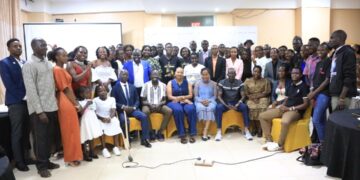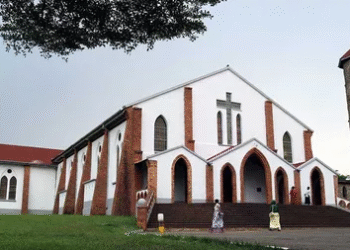In the face of so many difficult circumstances that we are experiencing, we remember the expression of the Servant of St. John Paul II: “The Rosary is my favorite prayer.”
THE FACE OF CHRIST.
Contemplating the face of Christ is the essential content of the Rosary. Just as the Transfiguration of Christ (Mt.17, 2) is the “icon of Christian contemplation”, the Rosary is an invitation to set the eyes of faith in the face of Christ, to contemplate the mystery of him from childhood, public life, passion, death, resurrection and the sending of the Holy Spirit, as a gift from the Father and the Son.
At the same time, the contemplation of Christ prepares us to embrace the Trinitarian mystery because the Son It is God as the Father in the love of the Holy Spirit who is God as the Father and as the Son.
LOOK AT CHRIST WITH MARY.
Mary is an unsurpassed model for learning to look at the face of Christ in faith. Christ belongs to you especially because he is the Son of his womb by the work of the Holy Spirit, because he contemplates his face of her like a mother that of her son, because she accompanies him maternally from the conception, birth, childhood, apostolate, passion, death and resurrection until the ascension, an attitude of adoration, because he loves his Son, who is God with a love of communion.
“Without contemplation, the Rosary is a body without a soul and its prayer runs the risk of becoming a mechanical repetition of formulas, contradicting the warning of Jesus”: “When you pray, do not be charlatans.” like the pagans, who believe they are listened to because of their loquacity”.
By its nature, the Rosary requires a calm rhythm and a reflective calm, which encourages those who pray to meditate on the mysteries of the Lord’s life, seen through the heart of the One who was closest to the Lord, and which reveal their unfathomable wealth” (MC 47).
From there, John Paul II gives us the most original part of the document, condensing into five key verbs – remember, understand, configure, pray and announce – the provisions for a profitable prayer of the Rosary.
a) Remember Christ with Mary. – It is about biblical “remembering”: remembering, with Mary, the saving events that God actualizes in history. “Penetrating from mystery to mystery, into the life of the Redeemer, it causes that what he has accomplished and what the Liturgy actualizes is deeply assimilated and forges his own existence” (n.13).
b) Understanding Christ from Mary. -No one like Mary, the teacher, the educator of Jesus, can help us understand not only the truths that he has revealed to us, but also understand him. “Going through the scenes of the Rosary with Mary is like going to Mary’s school to read Christ, to penetrate her secrets, to understand her message.” Mary’s school is very effective, since she exercises it with the abundant gifts of the Holy Spirit. She is, at the same time, teacher and model in the “pilgrimage of faith” (n.14).
c) Configure yourself to Christ with Mary. -Fundamental requirement of Christian spirituality is “the duty of the disciple to conform himself more and more to his Master.” With “the spiritual journey of the Rosary”, in the company of Mary we incessantly contemplate the face of Christ and thus creates a “friendly” assiduousness that “introduces us naturally into the life of Christ and makes us “breathe” his same feelings. “. It was what Saint Paul asked the Christians of Philippi: “Have in yourselves the same feelings of Christ” (2,5) (n.15).
d) Pray to Christ with Mary. -The Pope reminds us with the Catechism of the Catholic Church that “the prayer that Christ and the Holy Spirit make spring forth in our hearts, Mary intervenes with her maternal intercession.” “At the wedding at Cana, the gospel shows precisely the effectiveness of Mary’s intercession, who becomes spokesperson before Jesus for human needs: They have no wine” (Jn 2,3).” And he adds: “In the Rosary, as we supplicate Mary, temple of the Holy Spirit, she intercedes for us before the Father who has filled her with grace and before the son born from her womb, praying with us and for us” (n.16).
e) Announce Christ with Mary. – It is a logical conclusion, since “the Rosary, says the Pope, is also an itinerary of proclamation and deepening”: the contemplative, repeated, deepened, prayerful presentation of the mystery of Christ is a real help “to model the Christian according to the heart of Christ”. And in the community celebration – in parishes and sanctuaries – it constitutes “a significant catechetical opportunity” that is being taken advantage of. “In this way the Virgin of the Rosary also continues her work of announcing Christ.” And as in the past it was used effectively in difficult times for the Church, today it must be used in the face of new challenges; Well, “it retains all its strength and continues to be an important resource in the luggage of every good evangelizer” (n. 17).
Mary’s path to the mystery of Christ and man. – We conclude this reflection with another pearl from John Paul II in his apostolic letter on the Rosary. The Rosary can be called “the path of Mary” – a woman of faith, silence and listening – who helps us better understand the mystery of Christ, but also, says the Pope, “who contemplates Christ going through the stages of his life, also discover in Him the truth about man”… It is natural in that encounter with the holy humanity of the Redeemer, to present so many problems, worries, fatigues and projects that mark our life… Yes, truly the Rosary “marks the rhythm of human life”, to harmonize it with the rhythm of divine life, in joyful communion with the Holy Trinity, destiny and desire of our existence” (no. 25).
As we complete the Rosary Month of Mary, the Rosary is “contemplating with Mary the face of Christ”, it is a very rich source of biblical, Christological, Trinitarian and missionary spirituality; It is a powerful means to implore from God with Mary the gift of peace and family unity in the current crisis of the world. This is because Prayer is necessary, like water for trees and plants, like food for the body, like blood for the organism, like the foundation for the house, like the stomach for digestion, like oxygen for life.
Fr. Robert Nsinga Mccj








































